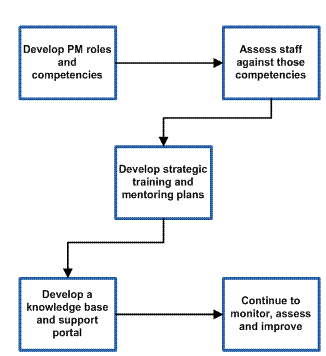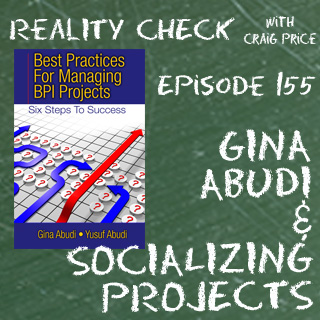Developing a Project Management Best Practice
Gina Abudi, MBA
Abstract
Executives today are interested in developing a best practice around project management within their organizations. Some of this interest stems from the economy and the need to do more with less – reduced timelines to get a product/service to market to increase revenue, smaller budgets to get projects completed, and reduced project management staff due to layoffs and/or restructuring. However, exactly what a “best practice” means is different from organization to organization and in many situations, within the organization the definition of a “best practice” differs from department to department or business unit to business unit. Many organizations are unsure how to go about defining what a “best practice” means for their organization as a whole and how to effectively go about developing a best practice that works for their organization. This paper will focus on the importance of developing a project management mindset – and therefore a best practice – within an organization; including the steps necessary to take to reach the end goal and how to get buy-in from key players within the organization to ensure success.
Introduction
First, let’s define a “best practice.”
- “A best practice is an optimal way currently recognized by industry to achieve a stated goal or objective.” (OPM3® Overview, PMI®, Page 9).
- “A best practice is an idea that asserts that there is a technique, method or process – through research and application – that is more effective at delivering a particular outcome than any other technique, method or process.” (Wikipedia definition)
No best practice is best for every organization, and every situation will change as individuals find better ways to reach the end result. (Businessdictionary.com) Organizations define the term “best practice” differently. For some, best practice refers to a consistent way of doing something. For others, best practice is simply ensuring that everyone in the project management function uses the same templates and software. Most organizations have some best practice already in place; they just don’t know it because it was not developed by someone high up in the organization and rolled out through the organization. However, project managers have their way of doing things – even if those methods are not formal within the organization. This “way of doing things” can be considered a best practice.
When organizations look at developing a best practice around the project management function, they usually mean one or more of the following:
|
|
Organizations desire to establish best practices to meet many needs, including:
- Effective management of project resources
- Alignment of projects to the strategic goals of the organization
- Improved tracking and reporting on projects’ status
- Reduction in the time and money spent on ensuring projects are brought to a successful conclusion
The continued success of organizations in an ever-changing, competitive marketplace requires that they have formalized their project management function and find improved ways of accomplishing their strategic goals. With a best practice in place, organizations are better able to make decisions on the types of projects to undertake in any given time period.
A Five-Step Approach
The following five-step approach (Exhibit 1 below) is one way to move forward with developing a project management best practice within an organization:

Exhibit 1 – 5 Step Approach to Developing a Project Management Best Practice
Each of these steps will be discussed in further detail later in this paper to demonstrate one method of moving forward in developing a project management best practice within an organization. Throughout each of these steps the key is frequent communication.
But First…Get the Organization in the Loop
Prior to getting started, the organization needs to be prepared for the change that is about to occur. Most important is to communicate the value to the organization of establishing a project management best practice. The organization’s staff needs to understand the direction the organization is heading in and why. Why do standards need to be put in place? What are the benefits to the organization? What are the benefits to the project management function? Many individuals may believe that things are going just fine as is; nothing needs to change. Remember also that people are resistant to change. You need to develop a team of champions to help you roll out such an initiative. Buy-in is required from all levels of the organization, not just from the top. Get those individuals who are using standardized processes to help in promoting the benefits and value to the organization and individuals in establishing standards around the project management function.
There are multiple ways for educating the organization including: executive overviews (for the senior members of the organization); “lunch and learn” sessions, informal water cooler conversations to create a “buzz” in the office, individual and small group discussions, and through an internal newsletter or via an intranet site.
Develop Project Management Roles and Competencies
Consider what project management roles exist within your organization. Are the roles formal or informal? If no roles exist, what is needed, e.g., Project Lead, Project Manager, Project Scheduler, Team Lead. Is certification required? Make your decision on roles needed based on a number of factors, including: types of projects, strategic goals, current project management functions within the organization, skills and expertise needed on projects, competition’s organizational structure, and the long-term strategic goals of the organization.
You will need to develop the competencies specific to each role and assess against those competencies. Competencies should include both technical competencies (9 knowledge areas of the PMBOK®) and management/leadership competencies (team skills, negotiation skills, conflict management, communication). Remember that technical project management skills along is not sufficient for success in project management – management/leadership skills are needed given the high interaction the project management function has with internal and external clients.
For each skill identified for various roles, what level of competency is required? For example, let’s assume you have a Project Scheduler role within the organization. That role requires individuals to be experts in scheduling, use of Microsoft® Project, and resource allocation. However, they only need to have basic knowledge of how to create the Work Breakdown Structure as that job is the responsibility of a Team Lead role within the organization. The Team Lead role must be experts in creating Work Breakdown Structures. Using that example, you will want to assess the individuals against the required competencies. You may assess the Team Lead against his/her capabilities in using Microsoft® Project and scheduling techniques, but you would not expect or require the Team Leads to be experts in these areas. For all roles, it is likely that a high competence level is required in influencing and communication skills. You would want to assess individuals, regardless of their role, in how effectively they can influence and communicate with others.
Assess Staff Against Those Competencies
There are a variety of methods to assess skills and the choice of how to assess skills should be based on what works best for your particular organization and the purpose of the assessment. Think about the purpose of your assessment – is it to:
- Determine strategic training needs
- Determine project management roles within the organization
- Determine skills to assign individuals to projects and project teams
- Gain a clearer understanding of the skills of project management staff to fill in the gaps
- To develop career paths for individuals in the project management function
There are many reasons to assess skills within the organization. Prior to assessing skills you need to have an understanding of why you are doing so. This is important so that you can effectively communicate why you are assessing, who is being assessed and what will be done with the results of the assessment.
Assessments can be in the form of subjective or objective assessments, group and one-on-one interviews, online surveys and through data gathered from internal resources such as human resources and individual business units. A combination of methods provides organizations with sufficient data to make strategic decisions around the project management function. It is recommended that you begin with a pilot group for the assessment to test the method being utilized and the usefulness of the data being returned. The ideal pilot group will be comprised of a number of individuals from across the project management function – from junior to more senior skilled individuals – with a variety of skills and competencies.
Once you have the pilot group assessed and results tabulated and analyzed, share the information with the individuals who were assessed and with key leaders within the organization. Do a post mortem with the individuals assessed – How did the process work from their perspective? How comfortable and confident were they about the assessment? How do they believe others in the organization will react to the assessment? What changes would they make? Based on what you have learned, make the changes necessary to roll out the assessment process organization-wide. If significant changes have been made, you may want to re-involve the pilot group in one more pilot of the assessment before roll-out.
Although this paper focuses on the individual, it is important to note that a full assessment would include project teams and the organization as a whole. When assessing project teams – look at the ability of the team to work effectively, the mix of skills on the team, the leadership of the team, and the team’s ability to achieve the desired results. (Frame, 1999, pp. 158-171) When assessing the organization, assess the support that the project management function receives – processes and procedures in place, access to necessary information, opportunities for training, clearly defined vision, open culture and institutionalization of project management throughout the organization. (Frame, 1999, pp. 182-183)
Develop Strategic Training and Mentoring Plans
Part of your goal should be to develop strategic training and mentoring plans for the project management function. Some training may be to meet short-term goals. For example, if you determine through the assessment that individuals are not highly skilled in identifying and planning for risk and that is a key component of managing projects at the organization, you want to ensure that there is a plan in place to improve those skills in as short a time frame as possible. This plan may include training focused specifically on project risk management, but may also include a mentoring component where individuals with stronger skills in risk management are paired with individuals who need to improve their skills in this particular area.
Some training may be to meet long-term goals and will likely be tied to career paths and formal mentoring and coaching programs. Such training programs should be focused on supporting and preparing for certification (CAPM®, PMP®, PgMP®) or credentials (such as Scheduling, Risk) and providing individuals with the skills needed to move into roles with more responsibility within the organization (such as from a Project Administrator role into a Project Scheduler role and, at some point, into a Project Manager or Program Manager role within the organization). Formal mentoring and coaching programs can be structured to ensure that individuals in the project management function get the support they need to continue to develop their skills and grow within the organization. Formal mentoring and coaching programs also provide senior level project/program managers with an opportunity to take on leadership roles in getting more junior members of the project management team up to speed and functioning effectively and successfully within the organization.
Regardless of the short- or long-term goals of the training, it is recommended that all training programs include an action planning component so that individuals have a plan to apply what they are learning back on the job with the support of their managers. Training itself will not improve the skills of individuals; the knowledge gained must be applied in practice if it is going to be effective. (Frame, 1999, pp. 62-63) Follow up training with a 3-month survey to determine how individuals are applying their newly learned skills and knowledge and what are the enablers and barriers to them continuing to apply those skills. Ask managers for their input on the training initiative – was it successful? What changes do they see in the project management staff? What else is needed?
Develop a Knowledge Base and Support Portal
A knowledge base/support portal can be a “one stop location” for all project-related information, along with providing those involved with projects a way to support each other. Any of the following could be part of the knowledge base/support portal:
|
|
This becomes a resource for the project management function to help each other by problem solving issues, sharing best practice, brainstorming, etc. Many organizations already have much of the information you would want in such a portal. All of that knowledge needs to be pulled together into one central location to better support the needs of the project management function. This can be the start of your PMO within the organization.
Continue to Monitor, Assess and Improve
Your work is not done yet! This is an ongoing process to ensure continuous improvement and keep the project management function growing and moving in the right direction. As with anything, changes will have to occur to meet the needs of the organization – changes to long-term strategy, mergers, new product lines, etc.
Key performance indicators (KPIs) should be determined. KPIs may include time to market, management of budgeted monies, percent of contracted resources used on projects, ROI of a strategic project, etc. Think where the project management function is today and where do you want it to be at some point in the future (6 months, 1 year, 3 years, etc.)? Determine your KPIs, set the baseline (where are you now?) and determine where you want the KPIs to be in the future. Map out a plan to reach your goal and re-assess against that baseline to determine progress. If you don’t see sufficient progress, determine the issue, problem-solve, and reset your strategy if necessary to get back on track.
For example, let’s assume that project resources are not well planned or allocated and frequently key projects have a higher percent of external contracted resources running them then internal resources. Currently, projects that are worth over $1 million have, on average, 65% contracted resources in key positions on the project. That is the baseline. The goal is to reduce the number of contracted resources to 50% within 6 months and then to 35% within 1 year, with a goal within 2 years of no more than 20% of contracted resources on projects worth over $1 million. A plan needs to be put in place to move from 65% to 50% in 6 months, 35% in 1 year and 20% within 2 years.
KPIs will differ from organization to organization and may even differ from business unit to business unit within the same organization. Think about what makes sense for your organization – where it is now and where it needs to go. KPIs should be evaluated regularly; possibly as part of a regular annual strategic planning session.
On an annual basis, the following should be done:
- Re-assess project management skill sets: Have improvements in skills been realized based on training and mentoring/coaching plans? Are other skills required due to changes in the business?
- Re-evaluate competencies for each project management role: Have needs changed due to changes in the business model or market strategy? Are other competencies required for various project management roles? Is there a new project management role within the organization? Has restructuring or layoffs affected the project management function thereby requiring additional skills for those remaining?
- Re-evaluate training and mentoring programs: Are the current training and mentoring programs in place still successful? Do they need to be adjusted based on new requirements within the business? Are current mentors getting a bit worn down and should others be given the opportunity to mentor? Are there new processes or standards that require training? Do the training programs meet the needs of project management staff given the focus on new skills and knowledge to get the job done?
- Re-evaluate project management processes and best practices: Do current processes need updating to meet new business needs? Best practices evolve – what are updated best practices? What are individuals/teams doing to make their job easier? What processes have individuals/teams been using that are not yet reflected organization-wide?
- Re-evaluate your KPIs: How are you trending against your KPIs? Do KPIs need to be adjusted based on changes to the business? Do new KPIs need to be determined and a baseline set? Do changes need to be made to how KPIs are being tracked?
Summary
It is important to remember that it is highly likely that the organization has some standardized processes and best practices in place. Even if they are informal and not known widely throughout the organization you want to understand what processes exist, who “owns” them, do they truly represent a best practice and, if so, how they might be incorporated organization-wide. Communication and getting buy-in is essential for success in developing a project management best practice. Start slowly – testing the waters as you go. Expect that you will have to make adjustments in your plans for developing an organization-wide best practice. Use as much of the current informal processes in place as possible; especially if they are already working effectively and the project management staff is comfortable with them. And again, it can’t be emphasized enough – Communicate! Communicate! Communicate!
References
Project Management Institute’s Organizational Project Management Maturity Model Overview, 9
Frame, J. Davidson (1999). Building Project Management Competence: Building Key Skills for Individuals, Teams and Organizations. Jossey-Bass Publishers, San Francisco, CA.
Wikipedia definition: http://en.wikipedia.org/wiki/Best_practice
Businessdictionary.com: http://www.businessdictionary.com/definition/best-practice.html
©2009, Gina Abudi, MBA
Originally published as part of 2009 PMI Global Congress Proceedings – Orlando, Florida, USA


